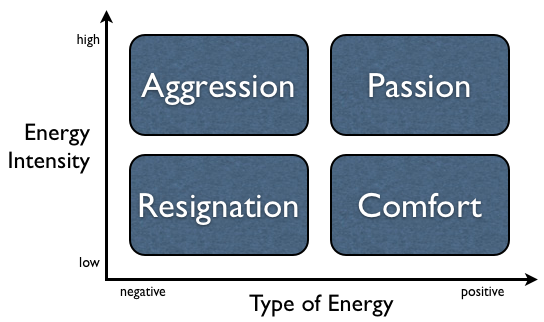- You are here:
- Home »
- Suggestions
- » Corporate Energy
Corporate Energy
Yes, this topic is a bit on the esoteric side I admit… but hear me out, there is logic and reason behind the glass. Some colleagues of mine use the following model to judge a company’s investment worthiness. I found it fascinating and have now evaluated a few hundred firms using this technique. Situations at a few companies that I previously worked with made me feel uneasy about the company and its culture but I did not know why. Today, I have a good idea what triggered my feelings and I have come to the conclusion that unless I can change things for the better, I would rather not work with such firms again. These firms were suppliers of mine as well as a few Customers. Read on and assess the technique for yourselves – I’d love to hear your thoughts.

Energy zones
An organization’s energy can be perceived as either positive (driven by enthusiasm, pride, joy or satisfaction) or negative (guided by fear, uncertainty, frustration, doubt or sorrow). Most organizations fall into one of four categories:
1) Comfort 2) Resignation 3) Aggression and 4) Passion.
Companies in the comfort zone have a high level of satisfaction but a low level of action. Thus, its employees might be very content on the one hand but they lack the vitality, alertness, motivation and emotional tension necessary for initiating bold new strategic thrusts or significant change.
Organizations in the resignation area, on the other hand, show both low and negative energy. Therefore, they are not particularly active and their employees may not identify with the company goals at all.
Businesses in the aggression area are driven by a strong, negative energy, which often expresses in an
intense internal competitive spirit and portrays in high levels of activity and alertness. Hence, unlike organizations in the resignation area, they often direct all power towards achieving company goals. The analogy here is of a ping pong match where employees hit the ball back and forth across the net either to other team members or to Customers and partners and the net result is dissatisfaction since the ball keeps coming back and there is little forward momentum as a unit. Despite progress by a few successful individuals – it is not a team effort.
Lastly, firms in the passion zone flourish and excel on their great positive energy and large amount of varying activities. Their employees feel joy and pride working in the organisation and all enthusiasm and excitement appears to be set on reaching shared organisational priorities.
Organizations in the comfort or resignation zones live in the past and have basically given up. Consequently, they are less likely to be successful, as they prefer standardised, institutionalized ways of working. They shun innovation and risk as well as suffer from conflicting priorities and a lack of
employee commitment.
Companies in the aggression or passion zones show urgency for productivity as they strive for larger-than-life goals. Their energy moreover supports them in aligning and channelling their powers and in directing them towards common goals and activities.
In short, the model suggests that high achieving organisations are full of energy. Businesses that work from a basis of passion or with passionate people for that matter, are likely to have the highest energy levels. Their work is not only driven by very positive factors but they do a lot to develop themselves and their people, too. Simply put, their cultures appear to be based on cohesion. The analogy here is of a football team (soccer for you folks in the USA) where the team has a common goal and each member knows his role within the team so that as a unit they are able to move the ball forward and achieve their goals together.
